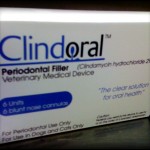New Therapy to Save Teeth Without Surgery
Clindoral Saves Teeth
The Problem With Pet Dentistry
Here’s the problem: your dog or cat or ferret has terrible breath. You can see yellow-brown calculus clinging to the teeth. You might even see bright red sore gum lines above the yellow tartar. You feel guilty that you waited so long to take care of the problem. You do not want your pet to loose any teeth. You are not a fan of anesthesia. Not for yourself, not for your children, not for your pet.
Did I get that all right? Pretty close? Yeah, I’m good like that.
So, up until now, your vet has put your pet under anesthesia, cleaned the teeth, and maybe pulled teeth that were hopelessly damaged. That’s fairly standard. News flash: There is no way around the anesthesia requirement for proper, effective tooth care in pets.
“There is no way around the anesthesia requirement for proper, effective tooth care in pets,” says Doc Truli.
However, you can take action to save teeth years before the scenario outlined above comes to fruition. Here’s how.
Periodontal Filler
While your pet is under anesthesia, and the technician is using the ultrasonic scaler to quickly and efficiently clean all the tartar and infected goo off of your pet’s teeth, the veterinarian performs a 6-point examination of each tooth. That’s 42 teeth in a normal adult dog and 30 teeth in a normal adult cat!
Some teeth might already be mobile. If a tooth actually wiggles, then it is not saveable. Period.
If the tooth is solid and does not wiggle, but the gum line around the tooth has been pushed away from the root by tartar and infection, then the pocket that results can be cleaned out and a periodontal filler material applied into the space between the tooth and the gums. Instead of bacteria, plaque and more tartar filling the pocket, medication in a special gel matrix can seal the pocket.
What is Clindoral?
Once your pet’s teeth are clean, and while your pet sleeps under anesthesia, we will apply the Clindoral liquid into pockets that need to heal.
How Will I Know If My Pet Needs Clindoral?
No one knows for sure until the full mouth examination and cleaning under anesthesia is completed. Doc Truli will call you and inform you that your pet’s teeth are treatable. With your knowledge and permission, we will treat the periodontal pockets.
“Dentists treat periodontal pockets all the time. In a human, the pocket might be a few millimeters deep. Usually, you pay per pocket, maybe something like $95 each. A human could have 10 or more pockets at a time. A dog could have a pocket that is 1/4-1/2 an inch, maybe 5 times the size of a human’s problem!” says Doc Truli.
How Does the Clindoral Work?
The periodontal pocket (an abnormal pouch in the gum line next to a tooth that easily holds bacteria and worse) undergoes a deep cleaning. Then the Clindoral is applied with a special tiny applicator. It goes in liquid and, upon touching the body, turns into a gel. The gel contains the antibiotic Clindamycin hydrochloride. (Clindamycin kills harmful mouth bacteria very effectively.)
The Clindamycin antibiotic migrates from the gel up into the gum tissue steadily over 15-20 minutes. By the time your pet wakes up from the anesthesia, the antibiotic already infuses the gum area right at the site of the problem, so no amount of licking or drooling can dislodge the Clindoral. The gum tissue re-adheres to the tooth, effectively eliminating the harmful pocket. The tooth lives longer.
References
Doc Truli’s Inspirational Pet Medical Stories Website, including Dental Stories
Official Clindoral product information
Dr. Jan Bellows, AVDC, AVBP, Veterinary Dental Specialist with a fabulous website full of pictures and explanations! (Dr. Bellows is a colleague of Doc Truli’s. They have worked together on many dental patients.)




When can I brush my dog’s teeth after the Peridontal Filler applied after his Dental Deep Cleaning? Thanks.
Dear Yu-chen Suen,
Thank you for your inquiry. Every patient may be different, so you should always follow your veterinarian’s advice. In general, yes, you can brush the teeth after the filler is applied. It is deep in the gingival pockets and will slowly absorb as it works. I advise my clients to wait 24 hours before brushing teeth after a deep dental cleaning. The gingiva may be painful or sensitive. However, plaque reaccumulates in 12-24 hours. Proper dental homecare is important to keep teeth healthy after the dental surgery. The scientific data insert for Clindoral can be found at this link: http://www.trilogicpharma.com/Clindoral%20IFU%20legal%20size_HA.htm